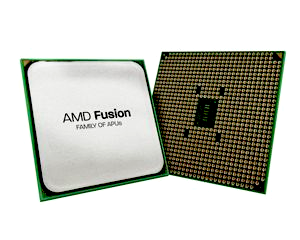AMD APU ignites new chip war with Intel
 Let the mobile device wars begin. Like AMD and Intel battled for desktop chip dominance in the 1990s and Noughties -- the megahertz and gigahertz wars -- mobile devices are their new territory. But instead of speed, the new marketing mantra is longer battery life, lower power consumption and better graphics capabilities. Following last month's Intel announcements for Ultrabook and "Medfield" processors, today AMD jumped in with Accelerated Processing Units (APUs).
Let the mobile device wars begin. Like AMD and Intel battled for desktop chip dominance in the 1990s and Noughties -- the megahertz and gigahertz wars -- mobile devices are their new territory. But instead of speed, the new marketing mantra is longer battery life, lower power consumption and better graphics capabilities. Following last month's Intel announcements for Ultrabook and "Medfield" processors, today AMD jumped in with Accelerated Processing Units (APUs).
The nomenclature makes me think of some wonky, scifi "B" movie or George Orwellian-like novel. But AMD's APU pitch is something more monumental.
In a statement, Rick Bergman, general manager of AMD Products Group, says the new chip category "represents an inflection point for AMD and is perhaps the industry's biggest architectural change since the invention of the microprocessor. It heralds the arrival of brilliant all-new computing experiences, and enables unprecedented graphics and video performance in notebooks and PCs. Beginning today we are bringing discrete-class graphics to the mainstream."
Those are some mighty big claims, and PC OEMs and software developers are embracing them. AMD claims APU will start shipping on as many as 150 notebooks, starting this quarter. I just got an email from CyberLink, which says its digital media products -- including PowerDVD 11 and PowerDirector 9 -- support APU.
Ten days ago, AMD announced that the first generation APUs, the Fusion A-Series, started shipping. Today's more formal announcement came during AMD's Fusion Developer Summit. Like Intel's Sandy Bridge, the A-Series chip, formally codename "Llano," is 32 nanometers -- but it supports up to four cores.
AMD lifted something from Apple's marketing playbook. About a decade ago, Apple pitched PowerPC Macs as supercomputers, something AMD is doing with APU A-series, claiming up to 400 gigaflops on notebooks and 500 gigaflops on desktops.
AMD and Intel both offer graphics rendering capabilities along with their microprocessors. That's really what APU means -- processor and graphics on the same chip. AMD touts HD capabilities and HTML5 support among the benefits. "AMD can make at least one important claim about its latest market entry: the high degree of integration and superior graphics performance suit the part ideally for mainstream notebooks that are great at handling visual media but still have long battery lives," Endpoint president Roger Kay says. "Beneficial thermal characteristics also allow the A-Series to be shoehorned into small desktops and sleek all-in-ones."
The chipmaker also claims more than 10.5 hours battery life -- a 50-percent increase over the 2010 AMD Mainstream Platform.
"The battery life of the AMD A-Series APU is a huge leap forward and will surprise many consumers and commercial customers," Chris Cloran, general manager of AMD's Client Division, says in a statement. Promises. Promises. I'll wait to see for myself.
"Whether Llano will be enough to help AMD break out of its limited share in the x86 market remains to be seen," Kay says, "but Fusion architecture and its realization in the company's new APU products give AMD the best shot it's had in years."
According to IDC, AMD's microprocessor market share, as measured in shipments, was 18.9 percent during first quarter. Intel: 80.8 percent.